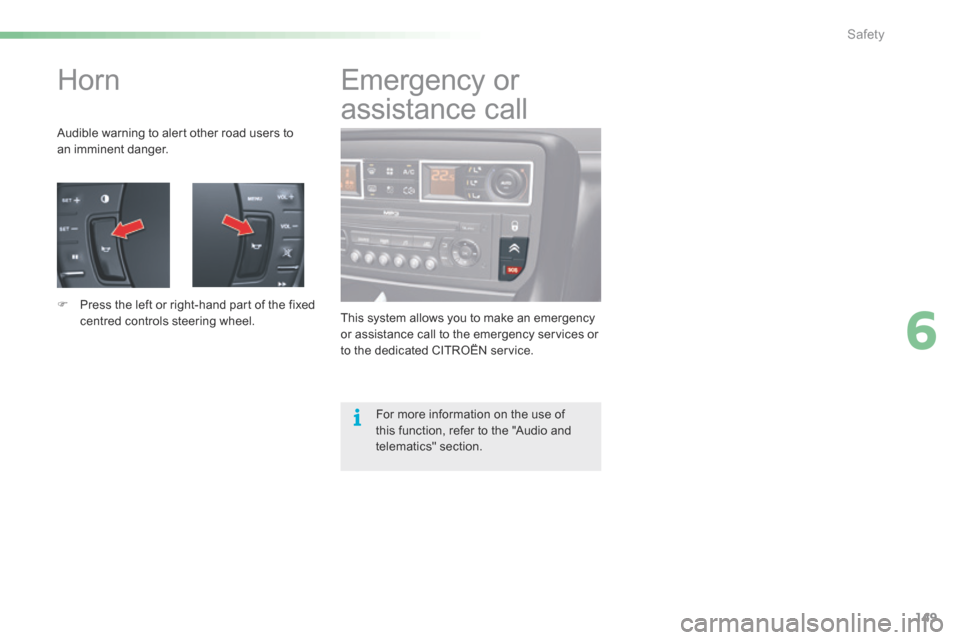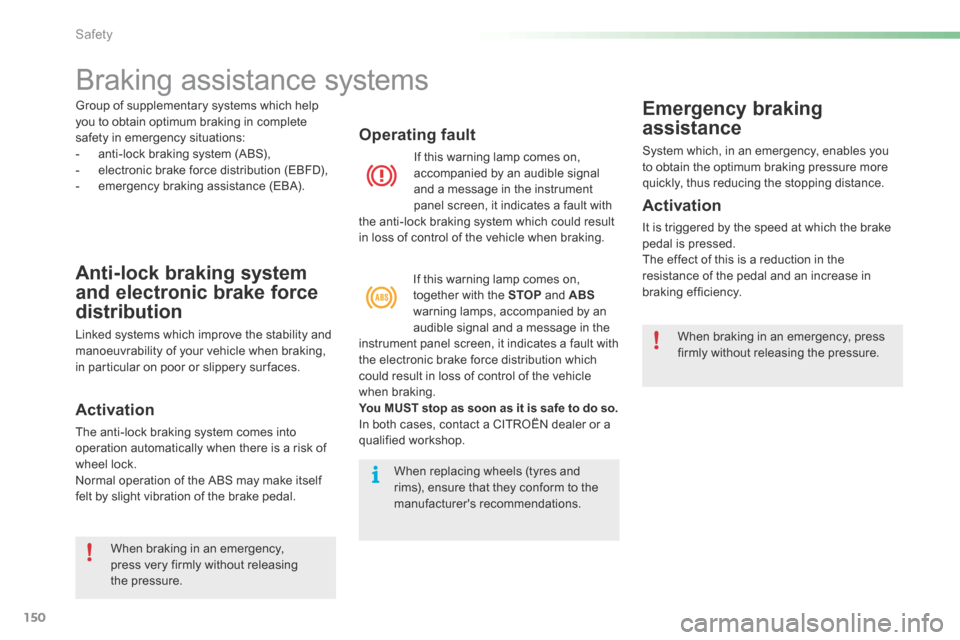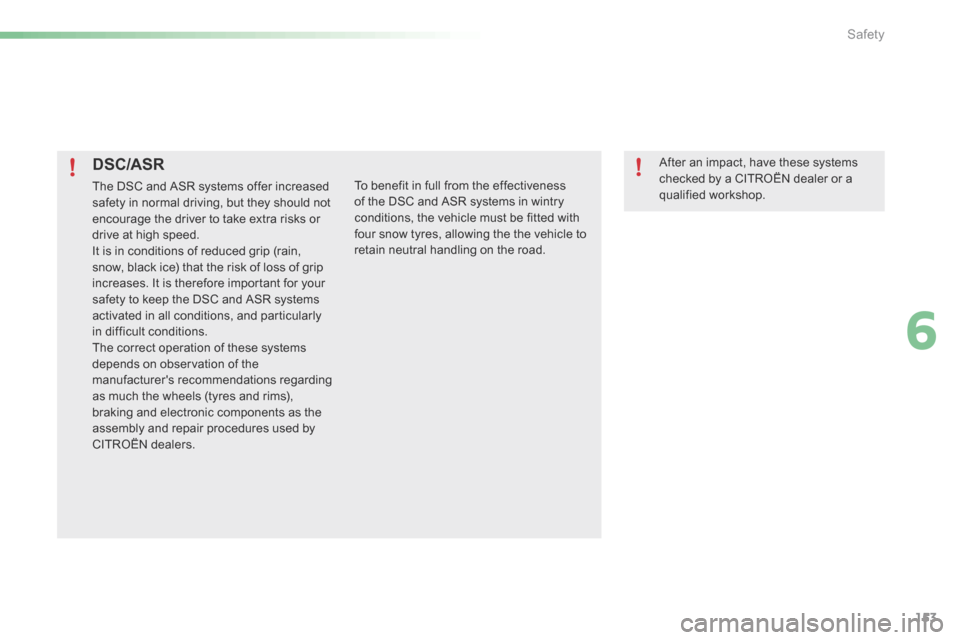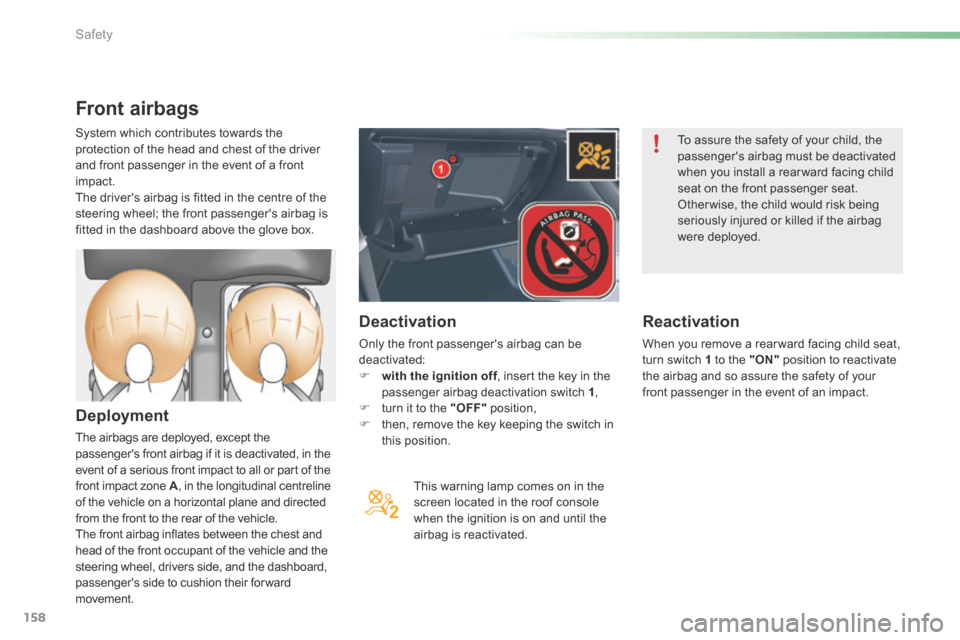wheel Citroen C5 RHD 2016 (RD/TD) / 2.G Owner's Guide
[x] Cancel search | Manufacturer: CITROEN, Model Year: 2016, Model line: C5 RHD, Model: Citroen C5 RHD 2016 (RD/TD) / 2.GPages: 362, PDF Size: 32.49 MB
Page 124 of 362

122
Speed limiter
Steering mounted controls
The speed limiter switches are located on the
left-hand side of the steering wheel.
1. Increase the programmed speed.
2. Decrease the programmed speed.
3. Speed limiter On / Pause.
4. Select speed limiter mode.
5. Deactivate the speed limiter.
Displays in the instrument panel
The information related to the speed limiter is
grouped together in zone A of the instrument
panel.
System which prevents the vehicle from
exceeding the speed programmed by the
driver.
When the limit speed is reached, the
accelerator pedal no longer has any effect.
The speed limiter is switched on manually: a
speed of at least 20 mph (approx. 30 km/h)
must be programmed.
The speed limiter can in no circumstances
replace keeping to speed limits or the
need for vigilance on the part of the driver.
Driving
Page 127 of 362

125
Cruise control
Displays in the instrument panel
The information related to the cruise control is
grouped together in zone A of the instrument
panel.
Steering mounted controls
The cruise control switches are located on the
left-hand side of the steering wheel.
1. a ctivate the cruise control at the current
speed of the vehicle, then increase the
programmed speed.
2. a ctivate the cruise control at the current
speed of the vehicle, then decrease the
programmed speed.
3. Pause / Restore the cruise control.
4. Select cruise control mode.
5. Deactivate the cruise control.
System which automatically maintains the
vehicle speed programmed by the driver,
without any action on the accelerator pedal.
The cruise control is switched on manually:
the vehicle speed must be at least 25 mph
(40 km/h) and you must be in at least:
-
4th gear for a manual gearbox,
- 2nd gear for an automatic gearbox.
The driver must remain attentive and in
complete control of the vehicle.
You are recommended to keep your feet
within range of the pedals .
4
driving
Page 137 of 362

135
Request not granted
The instrument panel screen temporarily displays a
message indicating that this position is not authorised.
The vehicle remains in the authorised position and the
instrument panel screen indicates this position to you.
Automatic variation of ground clearance
- If your speed exceeds 70 mph (approx.
110 km/h), on a good road sur face, ground
clearance is lowered. The vehicle returns
to its normal position if the road sur face
deteriorates or if your speed is lower than
55 mph (approx. 90 km/h).
- At low or medium speed, if the road sur face
is poor, ground clearance is increased. The
vehicle returns to its normal position as
soon as conditions allow.
- On switching off the ignition, the ground
clearance is reduced to the parking position
Normal position
If the speed authorised for a particular position
is exceeded, the vehicle reverts automatically
to the normal position.
Low position
To facilitate loading or unloading the vehicle.
For workshop inspections.
Not to be used in normal driving (not possible
if speed > 6 mph (10 km/h)).
High position
Changing a wheel (not possible if
speed > 6 mph (10 km/h)).
Mid-high position
For increased ground clearance (not possible
if speed > 25 mph (40 km/h)).
For use on difficult roads when travelling at
reduced speed, as well as on car park ramps.
For your safety if you are operating
underneath the vehicle, you must
suppor t the vehicle with axle stands.
4
Driving
Page 144 of 362

142
Directional lighting
without cornering lightingwith cornering lighting
"Cornering lighting" function
Activation
This function is activated:
- when the direction indicator is activated,
- from a certain angle of rotation of the
steering wheel.
Deactivation
This function is deactivated:
- below a certain angle of rotation of the
steering wheel,
- when stationary or at very low speed,
- when reverse gear is engaged,
- when the directional headlamps are
switched off.
With dipped or main beams, this function
provides additional lighting for the inside of a
bend, when the vehicle speed is below 25 mph
(approx 40 km/h).
This lighting is most useful when travelling at
low and medium speed (urban driving, winding
road, junctions, parking manoeuvres...).
Visibility
Page 151 of 362

149
Horn
Audible warning to alert other road users to
an imminent danger.
F Press the left or right-hand part of the fixed
centred controls steering wheel. This system allows you to make an emergency
or assistance call to the emergency services or
to the dedicated CITROËN service.
Emergency or
assistance call
For more information on the use of
this function, refer to the "Audio and
telematics" section.
6
Safety
Page 152 of 362

150
Braking assistance systems
Anti-lock braking system
and electronic brake force
distribution
Linked systems which improve the stability and
manoeuvrability of your vehicle when braking,
in particular on poor or slippery sur faces.
Activation
The anti-lock braking system comes into
operation automatically when there is a risk of
wheel lock.
Normal operation of the ABS may make itself
felt by slight vibration of the brake pedal.
Operating fault
If this warning lamp comes on,
accompanied by an audible signal
and a message in the instrument
panel screen, it indicates a fault with
the anti-lock braking system which could result
in loss of control of the vehicle when braking.
If this warning lamp comes on,
together with the STOP and ABS
warning lamps, accompanied by an
audible signal and a message in the
instrument panel screen, it indicates a fault with
the electronic brake force distribution which
could result in loss of control of the vehicle
when braking.
You MUST stop as soon as it is safe to do so.
In both cases, contact a CITROËN dealer or a
qualified workshop.
Emergency braking
assistance
System which, in an emergency, enables you
to obtain the optimum braking pressure more
quickly, thus reducing the stopping distance.
Activation
It is triggered by the speed at which the brake
pedal is pressed.
The effect of this is a reduction in the
resistance of the pedal and an increase in
braking efficiency.
Group of supplementary systems which help
you to obtain optimum braking in complete
safety in emergency situations:
-
anti-lock braking system (ABS),
- electronic brake force distribution (EBFD),
- emergency braking assistance (EBA).
When replacing wheels (tyres and
rims), ensure that they conform to the
manufacturer's recommendations.When braking in an emergency, press
firmly without releasing the pressure.
When braking in an emergency,
press very firmly without releasing
the pressure.
Safety
Page 153 of 362

151
Trajectory control systems
Anti-slip regulation (ASR) and dynamic stability
control (DSC)
Activation
This is indicated by flashing of this
warning lamp in the instrument panel.
Your vehicle has a system to improve traction
on snow: intelligent traction control
.
This system detects situations of low adhesion
that might make moving off and progress
difficult on deep fresh snow or compacted
snow.
In these situations the intelligent traction
control system regulates the amount of wheel
slip to optimise the traction and trajectory
control of your vehicle.
For vehicles with Hydractive III + suspension,
manual adjustment of ground clearance to
the intermediate position improves further the
ability to make progress in deep snow (see the
relevant paragraph).
The anti-slip regulation (also known as traction
control) optimises traction to prevent skidding
of the wheels, by acting on the brakes of the
driving wheels and on the engine.
The electronic stability control acts on the
brake of one or more wheels and on the engine
to keep the vehicle on the trajectory required
by the driver, within the limits of the laws of
physics.
Intelligent traction control
system ("Snow motion")
These systems are activated automatically
each time the vehicle is started.
They come into operation in the event of a grip
or trajectory problem.
The use of snow tyres is strongly
recommended on sur faces with low
adhesion.
6
Safety
Page 154 of 362

152
Reactivation
Operating fault
Illumination of this warning lamp and
the lamp in the deactivation button,
accompanied by an audible signal
and a message, indicate a fault with
the system.
Deactivation
Reactivate the systems as soon as the level of
grip permits.
F Press this button.
The indicator lamp in the button
comes on.
Contact a CITROËN dealer or a qualified
workshop to have the system checked.
The DSC and ASR systems no longer act
on the operation of the engine and on the
brakes in the event of a involuntary change of
trajectory.
F
Press this button again.
The indicator lamp in the button
goes off.
The systems are reactivated automatically
each time the ignition is switched back on or
from 30 mph (50 km/h).
Below 30 mph (50 km/h), you can reactivate
them manually:
In exceptional conditions (starting a vehicle
which is bogged down, stuck in snow, on soft
ground...), it may be advisable to deactivate
the DSC and ASR, so that the wheels can turn
freely and regain grip.
Safety
Page 155 of 362

153
DSC/ASR
The DSC and ASR systems offer increased
safety in normal driving, but they should not
encourage the driver to take extra risks or
drive at high speed.
It is in conditions of reduced grip (rain,
snow, black ice) that the risk of loss of grip
increases. It is therefore important for your
safety to keep the DSC and ASR systems
activated in all conditions, and particularly
in difficult conditions.
The correct operation of these systems
depends on observation of the
manufacturer's recommendations regarding
as much the wheels (tyres and rims),
braking and electronic components as the
assembly and repair procedures used by
CITROËN dealers.To benefit in full from the effectiveness
of the DSC and ASR systems in wintry
conditions, the vehicle must be fitted with
four snow tyres, allowing the the vehicle to
retain neutral handling on the road.
After an impact, have these systems
checked by a CITROËN dealer or a
qualified workshop.
6
Safety
Page 160 of 362

158
Front airbags
Deployment
The airbags are deployed, except the
passenger's front airbag if it is deactivated, in the
event of a serious front impact to all or part of the
front impact zone A, in the longitudinal centreline
of the vehicle on a horizontal plane and directed
from the front to the rear of the vehicle.
The front airbag inflates between the chest and
head of the front occupant of the vehicle and the
steering wheel, drivers side, and the dashboard,
passenger's side to cushion their for ward
movement. This warning lamp comes on in the
screen located in the roof console
when the ignition is on and until the
airbag is reactivated.
Deactivation
Only the front passenger's airbag can be
deactivated:
F
with the ignition off , insert the key in the
passenger airbag deactivation switch 1 ,
F turn it to the "OFF" position,
F then, remove the key keeping the switch in
this position. To assure the safety of your child, the
passenger's airbag must be deactivated
when you install a rear ward facing child
seat on the front passenger seat.
Other wise, the child would risk being
seriously injured or killed if the airbag
were deployed.
Reactivation
When you remove a rear ward facing child seat,
turn switch 1 to the "ON"
position to reactivate
the airbag and so assure the safety of your
front passenger in the event of an impact.
System which contributes towards the
protection of the head and chest of the driver
and front passenger in the event of a front
impact.
The driver's airbag is fitted in the centre of the
steering wheel; the front passenger's airbag is
fitted in the dashboard above the glove box.
Safety